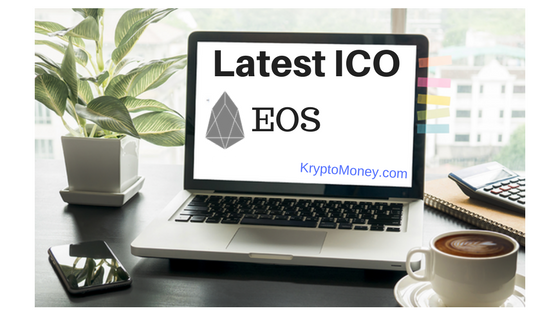
EOS, the first Blockchain operating system designed to support commercial decentralized applications, announced for its digital token distribution ICO to open on Monday, June 26. EOS’s token distribution follows a groundbreaking participation model that will take place over the course of one year creating the fairest token distribution project launched on Ethereum to date.
“To ensure inclusivity, EOS are not sold for a fixed price, but sold at a price determined by market demand; this mimics mining, but does not offer unfair advantages to large purchasers,” said Brendan Blumer, CEO of Block.one, the open source software and Blockchain company developing EOS.
Block.one will distribute one billion EOS ERC-20 compatible tokens, called “EOS Tokens” over 341 days starting it’s ICO on June 26, 2017 at 13:00 UTC following the below schedule:
->20 percent of EOS Tokens (200,000,000) will be distributed during the first 5 days of ICO book opening.
->70 percent of EOS Tokens (700,000,000) will then be split evenly into 350 consecutive 23 hour periods of 2,000,000 EOS tokens each starting July 1, 2017.
->10 percent of EOS Tokens (100,000,000) will be reserved for Block.one and cannot be traded or transferred on the Ethereum network.
At the end of the 5 day period and at the end of each 23 hour period referred to above, the respective set number of EOS Tokens set forth above will be distributed pro rata amongst all authorized purchasers, based on the total ether (“ETH”) contributed during those periods, respectively, as follows:
| Where:
a = Total ETH contributed by an authorized purchaser during the period. b = Total number of EOS Tokens available for distribution in the period. c = Total ETH contributed by all authorized purchasers during the period |
EOS is being designed to scale mainstream development for large enterprises, currently unsupported by existing Blockchain platforms. EOS introduces asynchronous communication and parallel processing to support millions of transactions per second, higher than that of Facebook and Google at 52 and 40 thousand per second, respectively.
EOS is being designed to support distributed applications that have the same look and feel of their centralized counterparts, eliminating the requirement for the user to pay for every transaction. This enables new Blockchain users to get involved without having to navigate the complex process of purchasing a cryptocurrency and should help to spur the industry. It also means any type of application can be built, run, and governed by EOS’s operating system, creating a new level of transparency for business.
->Brendan Blumer, CEO: Involved in the Blockchain industry since 2014, Brendan is a serial entrepreneur who has built businesses including trading of virtual currencies in MMORPGs in the US, okay.com in Hong Kong and 1Group in India.
->Daniel Larimer, CTO: A serial entrepreneur focusing on innovative technologies ranging from virtual reality simulators to second-generation crypto currencies, most notably BitShares. Dan is a specialist in software development and the inventor of the widely adopted “Proof of Stake” and “Decentralized Autonomous Corporations” concepts.
->Brock Pierce, Partner: A venture capitalist and entrepreneur who pioneered the market for digital currency in games and has raised more than $200 million for companies he founded. Brock is the Chairman of the Bitcoin Foundation, and co-founder of Blockchain Capital, among others.
->Ian Grigg, Partner: A financial cryptographer who has been building cryptographic ledger platforms for over 20 years, Ian is the inventor of the Ricardian Contract and the co-inventor of Triple-Entry Accounting.
All Blockchains are resource constrained and require a system to prevent abuse. With the EOS.IO software, there are three broad classes of resources that are consumed by applications:
->Bandwidth and Log Storage (Disk);
->Computation and Computational Backlog (CPU); and
->State Storage (RAM).
Bandwidth and computation have two components, Instantaneous Usage and Long-term Usage.
A Blockchain maintains a log of all messages and this log is ultimately stored and downloaded by all full nodes. With the log of messages it is possible to reconstruct the state of all applications.
The computational debt is calculations that must be performed to regenerate state from the message log. If the computational debt grows too large then it becomes necessary to take snapshots of the Blockchain’s state and discard the Blockchain’s history.
If computational debt grows too quickly then it may take 6 months to replay 1 year worth of transactions. It is critical, therefore, that the computational debt be carefully managed.
Block producers publish their available capacity for bandwidth, computation, and state. The EOS.IO software allows each account to consume a percentage of the available capacity proportional to the amount of tokens held in a 3-day staking contract. For example, if a Blockchain based on the EOS.IO software is launched and if an account holds 1% of the total tokens distributable pursuant to that blockchain, then that account has the potential to utilize 1% of the state storage capacity.
Using the EOS.IO software, bandwidth and computational capacity are allocated on a fractional reserve basis because they are transient (unused capacity cannot be saved for future use). The algorithm used by EOS.IO is similar to the algorithm used by Steem to rate-limit bandwidth usage.
The EOS.IO software is designed from experience with proven concepts and best practices, and represents fundamental advancements in Blockchain Technology. The software is part of a holistic blueprint for a globally scalable blockchain society in which decentralized applications can be easily deployed and governed.
For more details, please visit the organisation’s website.
KryptoMoney.com, posts latest news and updates about Bitcoin, Cryptocurrencies, Blockchain Technology and upcoming ICO’s. Subscribe to our newsletters to stay updated.
This article was contributed by author Bhargavi Sayee.
Also Read:
Latest Initial Coin Offer: DCORP, Decentralizing Venture Capitalism
Keep in mind that we may receive commissions when you click our links and make purchases. However, this does not impact our reviews and comparisons. We try our best to keep things fair and balanced, in order to help you make the best choice for you.